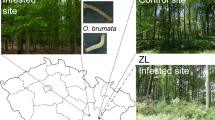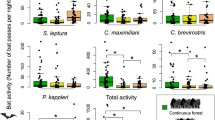We investigated potential defense behaviors of adult western spruce budworm (Choristoneura occidentalis), a non-auditive lepidopteran, against bat predation. Although western spruce budworm moths started to fly before sunset, earlier than many species of moths, temporal isolation of flying moths from foraging bats was incomplete as moths were most active after sunset once bats were foraging. Flying C. occidentalis were most active close to their host trees, and thus were isolated from some bat activity because vegetation limits foraging by some bats. Moths mostly flew near the tops of trees, an area that may have a high predation pressure from bats. Resting western spruce budworm spent little time fluttering their wings or crawling, behaviors that are used as cues by gleaning bats. The outbreak nature of this species, in which large numbers of moths are active at one time, may allow dilution effects to reduce predation risk.



Similar content being viewed by others
REFERENCES
Acharya, L. (1995). Sex-biased predation on moths by insectivorous bats. Anim. Behav. 49: 1461–1468.
Acharya, L., and Fenton, M. B. (1999). Bat attacks and moth defensive behaviour around street lights. Can. J. Zool. 77: 27–33.
Acharya, L., and McNeill, J. N. (1998). Predation risk and mating behavior: the response of moths to bat-like ultrasound. Behav. Ecol. 9: 552–558.
Alfaro, R. I. (1986). Mortality and top-kill in Douglas-fir following defoliation by the western spruce budworm in British Columbia. J. Ent. Soc. British Columbia 83: 19–26.
Campbell, R. W., Srivastava, N., Torgersen, T. R., and Beckwith, R. C. (1984). Patterns of occurrence of the western spruce budworm (Lepidoptera: Tortricidae): larvae, pupae and pupal exuviae, and egg masses. Environ. Ent. 13: 522–530.
Edwards, D. K. (1962). Laboratory determinations of the daily flight times of separate sexes of some moths in naturally changing light. Can. J. Zool. 40: 511–530.
Faure, P. A., and Barclay, R. M. R. (1994). Substrate-gleaning versus aerial-hawking: plasticity in the foraging and echolocation behaviour of the long-eared bat, Myotis evotis. J. Comp. Phys. A 174: 651–660.
Fenton, M. B., VanZyll De Jong, C. G., Bell, G. P., Campbell, D. B., and Laplante, M. (1980). Distribution, parturition dates, and feeding of bats in south-central British Columbia. Can. Field-Nat. 94: 416–420.
Fenton, M. B., and Bell, G. P. (1979). Echolocation and feeding behaviour in four species of Myotis (Chiroptera). Can. J. Zool. 57: 1271–1277.
Fullard, J. H. (1998). The sensory coevolution of moths and bats. In Hoy, R. R., Popper, A. N., and Fay, R. R. (eds.), Comparative Hearing: Insects, Springer, New York, pp. 279–326.
Fullard, J. H., and Napoleone, N. (2001). Diel flight periodicity and the evolution of auditory defenses in the Macrolepidoptera. Anim. Behav. 62: 349–368.
Greenbank, D. O., Schaefer, G. W., and Rainey, R. C. (1980). Spruce Budworm (Lepidoptera: Tortricidae) moth flight and dispersal: new understanding from canopy observations, radar, and aircraft. Can. Ent. 110: 1–47.
Hamilton, W. D. (1971). Geometry for the selfish herd. J. Theor. Biol. 31: 295–311.
Heinrich, B., and Bartholomew, G. A. (1971). An analysis of pre-flight warm-up in the sphinx moth, Manduca sexta. J. Exp. Biol. 55: 223–239.
Hoy, R. R., and Robert, D. (1996). Tympanal hearing in insects. Ann. Rev. Ent. 41: 433–450.
Jensen, M. E., Miller, L. A., and Rydell, J. (2001). Detection of prey in a cluttered environment by the northern bat Eptesicus nilssonii. J. Exp. Biol. 204: 199–208.
Jones, G., and Rydell, J. (2003). Attack and defense: interactions between echolocating bats and their insect prey. In Kunz, T. H., and Fenton, M. B. (eds.), Bat Ecology, University of Chicago Press, Chicago, pp. 301–345.
Jones, G., Barabas, A., Elliott, W., and Parsons, S. (2002). Female greater wax moths reduce sexual display behaviour in relation to the potential risk of predation by echolocating bats. Behav. Ecol. 13: 375–380.
Kurta, A., and Baker, R. H. (1990). Eptesicus fuscus. Mamm. Species. 356: 1–10.
Lewis, F. P., Fullard, J. H., and Morrill, S. B. (1993). Auditory influences on the flight behaviour of moths in a Nearctic site. II. Flight times, heights, and erraticism. Can. J. Zool. 71: 1562–1568
Morrill, S. B., and Fullard, J. H. (1992). Auditory influences on the flight behaviour of moths in a Nearctic site. I. Flight tendency. Can. J. Zool. 70: 1097–1101.
Roeder, K. D. (1967). Nerve Cells and Insect Behavior. Harvard Univ. Press, Cambridge, MA.
Rydell, J. (1998). Bat defense in lekking ghost swifts (Hepialus humuli), a moth without ultrasonic hearing. Proc. Roy. Soc. Lond. Ser. B. 265: 1373–1376.
Rydell, J. (2004). Evolution of bat defense in Lepidoptera: alternatives and complements to ultrasonic hearing. In Thomas, J. A., Moss, C. F., and Vater, M. (eds.), Echolocation in Bats and Dolphins, University of Chicago Press, Chicago, pp. 327–331.
Rydell, J., Entwistle, A., and Racey, P. A. (1996). Timing of foraging flights of three species of bats in relation to insect activity and predation risk. Oikos 76: 243–252.
Sanders, C. J. (1991). Biology of the North American spruce budworms. In Van Der Geest, L. P. S., and Evenhuis, H. H. (eds.), Tortricid pests, their biology, natural enemies and control. World Crop Pests 5: 579–620.
Sanders, C. J., and Lucuik, G. S. (1972). Factors affecting calling by female eastern spruce budworm, Choristoneura fumiferana (Lepidoptera: Tortricidae). Can. Ent. 104: 1751–1762.
Sower, L. L., and Daterman, G. E. (1985). Premating searching activity of male western spruce budworm moths Choristoneura occidentalis (Lepidoptera: Tortricidae). Can. Ent. 117: 1273–1274.
Thomas, D. W. (1988). The distribution of bats in different ages of Douglas-fir forests. J. Wildl. Manage. 52: 619–627.
Werner, T. K. (1981). Responses of nonflying moths to ultrasound: the threat of gleaning bats. Can. J. Zool. 59: 525–529.
Wilson, J. M. (2004). Foraging behaviour of insectivorous bats during an outbreak of western spruce budworm. MSc thesis, University of Calgary, Calgary, AB.
Wilson, J. M., and Barclay, R. M. R. (2006). Consumption of caterpillars by bats during an outbreak of western spruce budworm. Amer. Midl. Nat. 155: 244–249.
Zar, J. H. (1984). Biostatistical Analysis. 2nd ed., Prentice-Hall, New Jersey.
ACKNOWLEDGEMENTS
We thank J. Talerico and A. Camaclang for assistance with field work, G. Garthwaite, the Rey Creek Ranch, the Logan Lake Ski Club and C. Scott for access to study sites, and K. Buxton, L. Maclauchlan, D. Embury, L. Michaelson, L. Rankin, E. Begin and A. Stock of the British Columbia Ministry of Forests, and A. Carroll and J. Brandt from the Canadian Forest Service for advice and logistical support. R. Longair provided advice on insect behavior and commented on a previous version of this manuscript. Two anonymous reviewers made suggestions that significantly improved the manuscript. The project was funded by a grant from the Natural Sciences and Engineering Research Council of Canada (NSERC) to RMRB, an NSERC postgraduate scholarship and an Alberta Ingenuity scholarship to JMW, and a grant from Bat Conservation International to JMW.
Author information
Authors and Affiliations
Corresponding author
Rights and permissions
About this article
Cite this article
Lloyd, N., Wilson, J. & Barclay, R. Behaviors of Western Spruce Budworm Moths (Choristoneura occidentalis) as Defences Against Bat Predation. J Insect Behav 19, 533–544 (2006). https://doi.org/10.1007/s10905-006-9042-3
Published:
Issue Date:
DOI: https://doi.org/10.1007/s10905-006-9042-3




